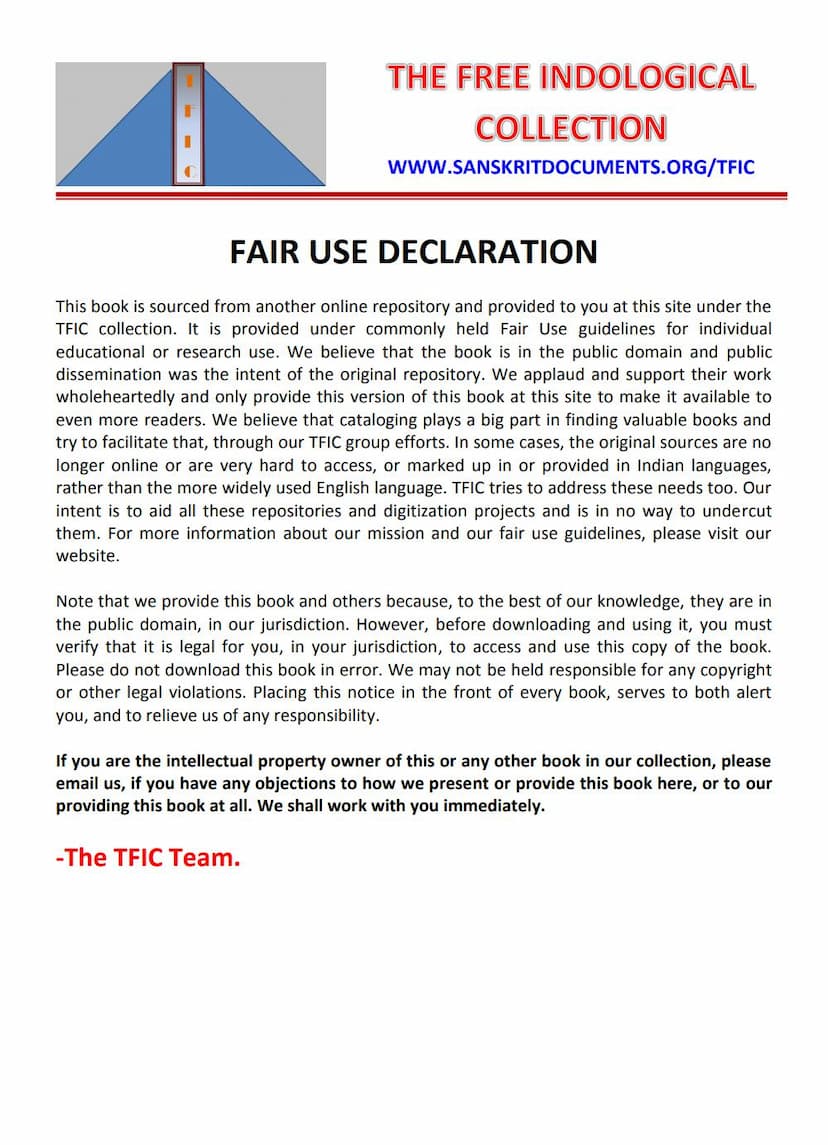Karma Story Of Buddhist Ethics
Added to library: September 2, 2025

Summary
This document is a digitized version of "Karma: A Story of Buddhist Ethics" by Paul Carus, published by The Open Court Publishing Company in 1903. The early pages include a "Fair Use Declaration" from "The Free Indological Collection" (TFIC) explaining their mission to make books available for educational and research purposes, believing this particular book to be in the public domain.
The book itself appears to be a narrative that illustrates key ethical principles of Buddhism, primarily focusing on the concept of Karma. The story is set in ancient India during the time of early Buddhism and follows the lives of several characters whose fates are intertwined.
Key elements of the story as presented in the provided text:
- The Jeweler Pandu and the Slave Mahâduta: The story begins with Pandu, a wealthy Brahman jeweler, traveling to Bârânasî. He is accompanied by his slave, Mahâduta.
- Encounter with the Samana Narada: Pandu encounters Narada, a Buddhist monk (samana), and offers him a ride. Narada shares Buddhist teachings with Pandu.
- The Incident with Devala the Farmer: Pandu's carriage is blocked by Devala's rice-cart, which has a broken wheel. Impatient and arrogant, Pandu orders his slave Mahâduta to overturn the cart and scatter the rice, worsening the farmer's plight. Narada, witnessing this, explains to Pandu that Devala is an incarnation of one of his ancestors and that his actions will have karmic consequences.
- The Jeweler's Purse: Later, Narada finds Pandu's lost purse, which contains a significant amount of gold. He instructs Devala to return it to Pandu and to forgive him, emphasizing that prosperity is linked to the well-being of others.
- Business in Benares: Pandu arrives in Benares and faces business difficulties due to a rice market corner. His friend Mallika is also in distress. Meanwhile, Pandu's slave, Mahâduta, falsely accused of theft, endures torture. Devala's timely return of the purse resolves Pandu's financial woes. Pandu seeks further explanation from Narada, who expounds on the illusion of self and the importance of altruism.
- The Robber Mahâduta's Fate: Years later, Pandu is robbed by a band of brigands led by Mahâduta, who was abandoned by Pandu after the purse incident. Pandu, now more enlightened, accepts his misfortune as a consequence of past karma. Mahâduta, now a robber chief, is later found mortally wounded after a battle with his own men.
- The Spider-Web Analogy: A young samana, Panthaka (a disciple of Narada), finds Mahâduta and tends to his wounds. Mahâduta confesses his past actions and expresses remorse. Panthaka recounts the story of the robber Kandata and the spider's web to illustrate how attachment to the self (egoism) prevents spiritual progress, leading to a fall. Mahâduta expresses a desire to follow this path.
- Mahâduta's Conversion and Death: Mahâduta, in his dying moments, confesses to Panthaka that he was Pandu's former slave and had robbed Pandu. He asks Panthaka to inform Pandu and arrange for the return of the stolen goods as a way to atone for his sins. He dies converted, having embraced the teachings of Buddha.
- The Converted Robber's Tomb: Pandu retrieves his stolen treasures. Mahâduta and his comrades are honored and buried. Panthaka delivers a sermon on Karma, emphasizing that individuals are responsible for their own actions and are interconnected, thus sharing responsibility for the misdeeds of others.
- Pandu's Bequest: Pandu, in his old age, passes on the wisdom of karma and self-reflection to his descendants, urging them to live ethically and remember the lesson: "Who injureth others Himself hurteth sore. Who others assisteth, Himself helpeth more."
Central Themes:
- Karma: The core concept is that actions have consequences, shaping one's present and future lives. The narrative illustrates how past deeds influence present circumstances and how present actions create future karma.
- Interconnectedness: The story highlights that individuals are not isolated but are linked to others, and their actions have ripple effects on the community and the world.
- The Illusion of Self: A key teaching is the Buddhist concept of "anatta" or no-self, where the perceived separate self is an illusion that leads to suffering and negative karma. Overcoming this illusion is crucial for spiritual liberation.
- Compassion and Forgiveness: The narrative promotes the idea of repaying ill will with kindness and emphasizes the benefits of forgiveness for both the forgiver and the forgiven.
- Ethical Living: The story serves as a moral guide, illustrating the virtues of kindness, generosity, and righteous conduct, and the consequences of vice and selfishness.
The introductory and concluding sections of the provided text also indicate that this story was popular and translated into multiple languages, even being recommended by Leo Tolstoy. The illustrations by Kwason Suzuki are mentioned, suggesting an artistic presentation of the narrative. The book is presented as a means to understand Buddhist ethics through a relatable story.